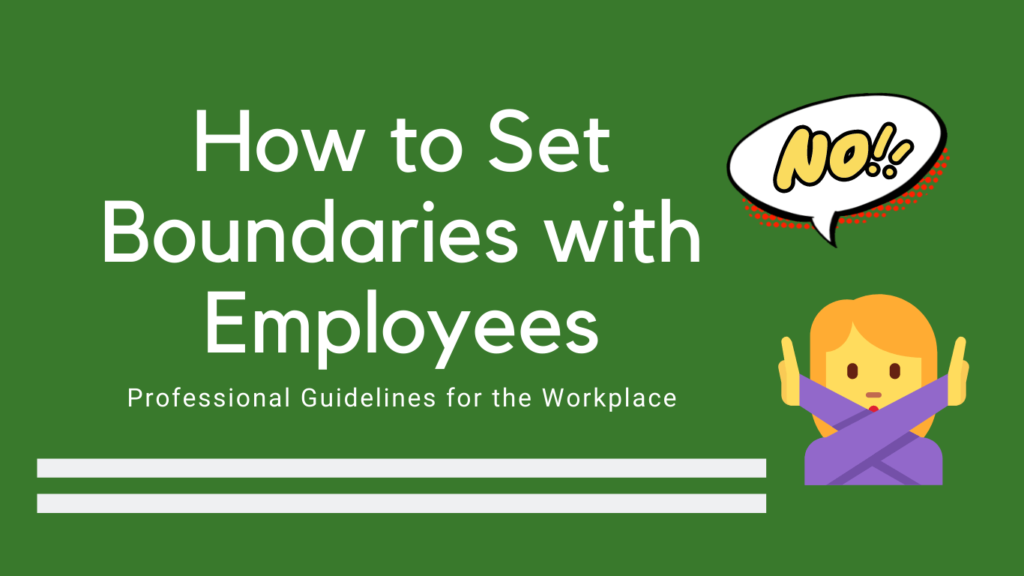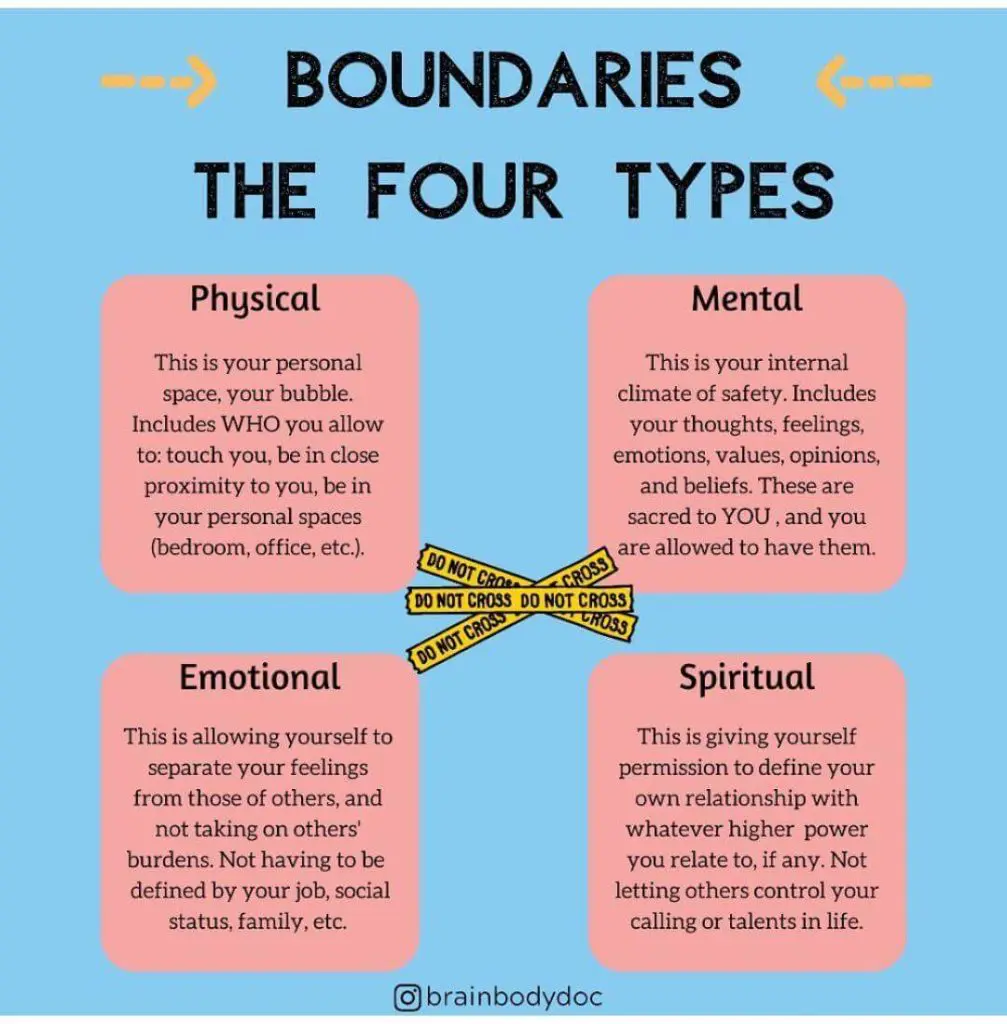How to Set Boundaries with Employees: Professional Guidelines for the Workplace

Boundaries are such a blurry line! In general, as a manager or an employer, how can you identify when you can be friendly without jeopardizing your status as a boss? Yes, there is a fine line between being a boss and a friend to your employees!
We know you want to be friendly and personable, but you must also set boundaries and enforce rules. If you don’t set limits, you could end up crossing the line and becoming too “approachable“, which can lead to problems in the workplace. In this blog post, we will discuss how to set boundaries with employees and create professional guidelines for the workplace. Keep reading!

What Are Boundaries About?
Boundaries are the lines that we draw in our lives to define what is and is not acceptable. They represent our values and beliefs and help to keep us safe both physically and emotionally.
Boundaries can be helpful in relationships because they provide clarity and help to prevent misunderstandings. Boundaries are not selfish, they are self-care
When we set boundaries with others, we are telling them what we will and will not tolerate. For example, we might set boundaries around our time, energy, or emotions. We might also set boundaries around physical space, such as personal boundaries or property boundaries.
Boundaries: Why Are They So Important?
Boundaries are key in any relationship, especially those involving a power dynamic. In a professional setting, it is important to maintain healthy boundaries to ensure that the workplace relationship remains respectful and productive.
Boundaries protect us from being taken advantage of, from becoming overwhelmed, and from feeling responsible for another person’s happiness. They also allow us to set limits on what we are willing to do and what we are not willing to do. When we have boundaries, we are saying “no” to some things in order to say “yes” to others.
Boundaries help us to take care of ourselves so that we can be available to take care of others

Basically, boundaries are part of a healthy routine! Now, do all boundaries are the same? That would be a no! There are different types of boundaries that we can set in our lives. Let’s explore the different types of boundaries below:
Types of Boundaries
Generally speaking, there are four main types of boundaries: physical, emotional, mental, and spiritual. Yet, we will add two more to nourish the topic: intellectual and time.

Physical Boundaries
Physical boundaries are the limits that we set around our bodies. They include our personal space, our property, and our possessions. These boundaries define personal space and can help to prevent physical harassment or assault.
We decide who can enter our space and who cannot. We also decide what physical touch is appropriate and what is not
For example, you might have an employee who prefers not to be touched, even in a friendly way like a pat on the back. Or you might work in an office where people keep their doors closed to signal that they don’t want to be disturbed.
Besides this, they help to create a more professional environment and can prevent potential accidents. For example, physical boundaries can help to define the workspace and keep employees from tripping over cords or equipment. They can also help to keep dangerous materials out of reach.
Emotional Boundaries
Emotional boundaries are the limits that we set around our emotions. They include our thoughts, feelings, and reactions. We decide how much we are willing to share with others and what we expect from them in return.
Emotional boundaries define how people should interact with each other in the workplace and can help to prevent emotional manipulation or abuse
It’s important to maintain emotional boundaries at work. This means keeping your personal life and emotions separate from your professional life.
There are a few key ways to do this.
- First, avoid sharing too much personal information with your coworkers, or employees if you are the manager. It’s okay to be friendly, but you don’t need to share intimate details about your life.
- Second, don’t get too involved in office gossip. It’s easy to get caught up in workplace drama, but it’s important to stay above it.
- Finally, don’t take things personally. There will always be workplace stressors, but it’s important to remember that they’re not always about you.
Mental Boundaries
Your mental boundary is what allows you to remain calm and focused while working. When you have a mental boundary, you’re able to separate your work from your personal life. This means that your work doesn’t affect your mental state outside of work.
You are also able to separate your colleagues from your friends. This way, you can have healthy relationships with both groups of people
For example, saying “no” to certain things at work can help you to maintain a healthy mental boundary. For example, you might say “no” to working overtime, or you might say “no” to taking on a project that is outside of your job description.
Spiritual Boundaries
Spiritual boundaries are the limits that we set around our beliefs and values. They include our religious beliefs, ethical values, and moral principles. We decide how much we are willing to compromise and what we expect from others in return.
Spiritual boundaries can help to prevent conflicts between employees or managers
For example, if you have a religious belief that doesn’t allow you to work on Sundays, you can set that as a boundary. Or if you have an ethical objection to a certain type of work, you can set that as a boundary as well.
A few key ways to maintain spiritual boundaries include:
- First, be clear about your beliefs and values. If you’re not sure what you believe or value, take some time to explore it.
- Second, be assertive about your boundaries. Don’t be afraid to speak up if you feel like someone is trying to transgress your boundary.
- Finally, be respectful of other people’s beliefs and values. Just because someone has a different belief or value than you doesn’t mean that it’s wrong.
Intellectual Boundaries
There are many intellectual boundaries that we encounter in the workplace. We may not realize it, but we are constantly interacting with colleagues and clients who have different levels of education, experience, and knowledge.
These boundaries define who has access to information and can help to protect trade secrets or sensitive information
Trying to cross an intellectual boundary can lead to conflict, so it’s important to be aware of them. A few key ways to maintain intellectual boundaries include:
- First, be clear about what information is confidential or sensitive. If you’re not sure, ask your boss or a trusted colleague.
- Second, don’t share more information than necessary. When in doubt, err on the side of caution.
- Finally, respect other people’s intellectual property. This includes things like ideas, plans, and designs. If you want to use someone else’s idea, make sure you get permission first.
Time Boundaries
It’s no secret that the modern workplace can be a demanding environment. With the rise of technology, many of us find ourselves working longer hours and dealing with a constant stream of information.
These boundaries define when people are expected to be available for work, and can help to prevent excessive overtime or burnout
While there are many advantages to this new way of working, it can also be challenging to maintain a healthy work-life balance. That’s why time boundaries are a must! A few ways are:
- First, set limits on how much work you’re willing to do outside of work hours. This means not checking work email after hours or working on weekends unless it’s absolutely necessary.
- Second, taking breaks during the workday. This gives your mind a chance to rest and rejuvenate.
- Finally, learning to say no. You don’t have to say yes to every project or task that’s assigned to you. If you’re feeling overwhelmed, it’s okay to say no.
Knowing the type of boundaries paves the way to successfully setting boundaries at the workplace, yet how exactly do we do it? Let’s get on the guidelines!
How to Set Boundaries with Employees: Professional Guidelines for the Workplace
To offer a really professional guideline, we will follow the model offered by Davidson in 2007 in his work: “Professional relationship boundaries: A social work teaching module. Social Work Education”
Now, this work is mostly focused on social workers, yet aren’t we social creatures by nature? Let’s quote Davidson a bit!
“Social workers are often challenged by the complex and ever‐changing dynamics within their relationships with clients, and struggle to find ethical responses within professional boundary gray zones where boundaries with clients can be difficult to identify, yet easy to cross.”
“Managers are often challenged by the complex and ever‐changing dynamics within their relationships with employees, and struggle to find ethical responses within professional boundary gray zones where boundaries with employees can be difficult to identify, yet easy to cross.”
That worked wonders if you ask us!
Davidson’s ‘continuum’ model (outlined below) appeals as a starting point for managers.

Let’s adapt the model to our topic:
Entangled
This is where the manager is fully immersed in the employee’s life, to the point where there are no boundaries between their professional and personal relationship.
Balanced
The manager and employee have a close working relationship, but there are still clear boundaries between their work and personal lives.
Rigid
The manager keeps their distance from the employee. There may be some interaction, but it is mostly in a professional and very business-like fashion.
Of course, we would want to avoid being engaged in an entangled type of relationship, considering a balanced relationship as the perfect scenario. However, in some professional settings, a rigid relationship is the one that works the best.
What type of relationship do you want to have at your workplace? Are you team balanced or team rigid?
You already decided which type of relationship you want to build and maintain at your organization. Either way, there are some crucial elements you need:
Assertiveness
Assertiveness is the quality of being self-assured and confident without being aggressive. Yes, confident in the sort of dynamic you want your workplace to have. It’s not like you will act hot and cold with your employees during the week!
Also, this means being coherent with the company’s culture. Assertiveness can help to prevent conflict and to ensure that everyone is on the same page.
Clear and Concise Communication
Remember this is not about being abrupt or impolite! You want to be clear when setting expectations and rules. For example, if your workplace is the type where a rigid relationship with your employees works best, then you want to be clear about it from the beginning.
Sometimes it’s not about employees trespassing boundaries, they just didn’t know there was one in the first place!
Write the Rules!
Concretely speaking, you will want to write down the rules and boundaries. This can help avoid any misunderstanding and it’s a great way to ensure that everyone is on the same page.
Moreover, it will also be easier for you to hold employees accountable if needed. Writing things down also reinforces the message that you’re serious about these boundaries. If the rules change, notify me!!!!
Don’t Avoid Confrontation
Easy, this is not an MMA ring! But, what is a fact is that a part of being a manager is to address a conflict as soon as it arises! If an employee steps out of line, then it’s important to handle the issue head-on.
Consistency
This is probably one of the most important guidelines of all. You need to be consistent with what you say and do. Employees need to know that they can rely on you. If you show them that your rules are fluid or self-promoting they will feel like they can’t trust you.
Willingness to Listen
Ultimately, you are the boss, yes, but it is key that you are willing to listen to your employees, if you don’t you will be left without any employees to manage, we guarantee you that!
If employees feel like their voices are not being heard then it can lead to frustration and a feeling of being unvalued resulting in low employee retention rates.
Takeaway
Trying to set boundaries with employees without a clear plan is a recipe for disaster. Use the tips and guidelines above to help you create a professional, cohesive work environment where everyone knows and respects the rules.
Take into account that there are countless benefits of setting boundaries at work. A few of them are:
- Helps your employees focus on their job
- Reduces stress and anxiety
- Improves communication
- Increases productivity
- Creates a healthy work environment
- Sets the tone for a professional relationship
If you are looking for more tips on how to be a great boss, check out our other blog posts!
-The Monitask Team


